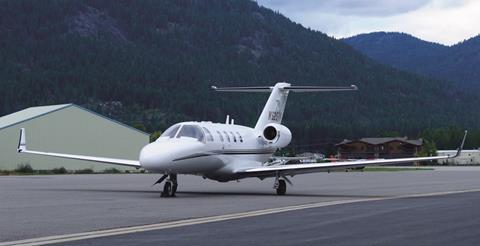The National Transportation Safety Board (NTSB) says that a 2018 accident that killed three was caused by Tamarack Aerospace’s Atlas active winglet system.
In a final report released on 1 November, the safety regulator says that the “Tamarack Active Camber Surface”, or TACS in short, on the left wing was deployed asymmetrically, and led to the the Cessna Citation jet crash.
TACS are active aerodynamic control surfaces mounted on the wing-tip extensions that either hold their position in trail with the wing or deploy symmetrically to alleviate structural loads, NTSB says.

“The circumstances of the accident are consistent with asymmetric or trailing edge up deployment of the left TACS for reasons that could not be determined,” the NTSB writes in its report. “The resultant roll rate, although above the nominal threshold for detection by the human vestibular system, likely went unrecognised by the pilot, due primarily to the pilot’s attention being directed toward a checklist and communications with a controller, a lack of visible horizon because the airplane was in the clouds, and the autopilot engagement.”
“After the autopilot disconnected, the pilot was audibly surprised and did not reduce engine power or deploy the speed brakes. The pilot was not able to regain control before collision with terrain,” the NTSB adds.
The cross-country flight of the aircraft with the registration N525EG began at Clark Regional airport in Jeffersonville, Indiana, and was bound for Chicago’s Midway International airport. The aircraft was climbing to an altitude of 10,000ft in instrument meteorological conditions when it entered a left roll from which the pilot could not recover.
The jet crashed into terrain just under 3min after taking off and 35sec after entering the roll.
For its part, Tamarack disputes the NTSB’s conclusions. Its winglets were “fully operational and did not cause or contribute” to the November 2018 accident, the Sandpoint, Idaho-based company says on 3 November.
“We disagree with the [NTSB’s] final report today that concludes active winglets installed on the aircraft N525EG were the probable cause of the accident, alleging there was, ‘asymmetric deployment of the leftwing load alleviation system for undetermined reasons’,” Tamarack says. “The forensic evidence collected in the investigation indicates that the load alleviation system was indeed operational, and deployed symmetrically, upon impact. There are inconsistencies within the report that do not support the conclusion published by the NTSB.”
Following the accident, regulators in Europe and the US effectively grounded 91 Cessna Citation light business jets that had been retrofitted with the company’s Atlas active winglet system malfunctioned on a handful of occasions. This resulted in in-flight upsets from which pilots struggled to recover.
Tamarack entered Chapter 11 bankruptcy proceedings on 1 June 2019, from which it emerged at the end of August this year.
Regulators lifted the grounding in July 2019, and Atlas-equipped Cessnas returned to service.
“We believe all parties and aviation as a whole are interested in considering all the facts of the accident, resulting in an accurate probable cause finding by the NTSB that will lead to preventing future accidents involving aircraft,” Tamarack says.
The company adds that it will ask the NTSB to reconsider its findings.



















